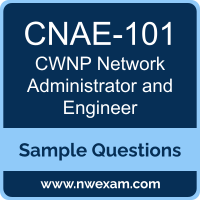01. What methods help forecast future network performance and capacity needs?
(Choose two)
a) Increasing firewall throughput by default
b) Establishing baseline performance metrics
c) Trend analysis from monitoring tools
d) Extending ARP cache timers
02. How does understanding CapEx vs. OpEx help network leaders when planning large infrastructure investments?
a) It informs procurement strategy and aligns with financial accounting models
b) It dictates BGP routing behavior during failover
c) It ensures consistent DNS TTL enforcement
d) It eliminates the need for asset tagging
03. Which type of network access control mechanism ensures only compliant devices are allowed on the network by checking their security posture?
a) 802.1X port-based ACL
b) Default VLAN segmentation
c) DHCP relay snooping
d) Posture-based NAC enforcement
04. In a cloud-integrated network, which design features help support workload mobility across on-prem and cloud environments?
(Choose two)
a) Use of SD-WAN overlays for abstraction
b) NAT for internal traffic between cloud VMs
c) Consistent IP addressing and DNS integration
d) Static routing between segments
05. When a BGP session fails to establish between two routers, what is the first diagnostic step you should perform?
a) Check the configured OSPF neighbor relationships
b) Verify TCP port 179 connectivity between peers
c) Confirm VLAN tagging across the WAN trunk
d) Review access control lists on the switch interfaces
06. Which conditions can cause performance degradation in cloud-hosted applications from a branch site?
(Choose two)
a) High jitter and packet loss over the WAN link
b) Absence of DNS load balancing records
c) Subnet overlap with cloud-native IP ranges
d) OSPF cost misconfiguration
07. During a routing issue in a large enterprise network, you observe that one site is unreachable via OSPF. What is the most likely reason?
a) The interface MTU exceeds the EIGRP limit
b) A missing OSPF area assignment on an interface
c) The switch’s STP timer is too high
d) The VRRP priority is incorrect
08. Why is lifecycle management important in network infrastructure planning?
a) It ensures proactive upgrades, supportability, and avoids equipment obsolescence
b) It defines the port-level VLAN mappings for network switches
c) It eliminates the need for redundancy in WAN topologies
d) It manages BGP routing across data centers
09. Which financial planning activities are essential when preparing an annual network budget proposal?
(Choose two)
a) VLAN-to-subnet mapping table
b) Weekly backup restore testing
c) Forecasting equipment replacement cycles
d) Estimating software licensing and maintenance costs
10. What are effective design strategies when implementing QoS in a mixed voice/video/data environment?
(Choose two)
a) Classify and mark traffic at the network edge
b) Encrypt all video streams for compliance
c) Reserve bandwidth using DSCP and queuing
d) Throttle voice traffic to reduce spikes
 Before you write the CWNP Network Administrator and Engineer (CNAE-101) certification exam, you may have certain doubts in your mind regarding the pattern of the test, the types of questions asked in it, the difficulty level of the questions and time required to complete the questions. These CWNP Certified Network Administrator and Engineer (CNAE) sample questions and demo exam help you in removing these doubts and prepare you to take the test.
Before you write the CWNP Network Administrator and Engineer (CNAE-101) certification exam, you may have certain doubts in your mind regarding the pattern of the test, the types of questions asked in it, the difficulty level of the questions and time required to complete the questions. These CWNP Certified Network Administrator and Engineer (CNAE) sample questions and demo exam help you in removing these doubts and prepare you to take the test.